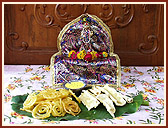Vijaya Dashmi

Also commonly known as Dashera, this
festival occurs on Aso sud 10.
Origin
There are many stories related to this festival:
1) As we saw in Navratri, the Lord's Shakti, Parvati, vanquished
the demon Mahishasur on the 10th day after a 9-day battle. This
is cited in the Skanda Puran. The sentiment here is that the uncontrolled
indriyas are only conquered by the Lord's Shakti.
2) On this day Lord Ram vanquished Ravan. Therefore people
celebrate the Lord's victory by burning Ravan's effigy on this day.
3) Dhaumya rishi's son, Mahaar married Shami, daughter of
Aarva rishi, of Malwa. After marriage both were on their way to
have darshan and blessings of Shaunak rishi. On the way they met
Bhrachundi rishi who had a trunk on his head. Seeing this the two
made fun of him. The rishi cursed them and both turned into trees.
For succor both prayed to Ganeshji. He blessed them that they would
be offered worship. From this day people offer pujan to the Mahaar
tree and Shami tree (commonly known as 'Khijdo', Latin-Prosopis
spicigera ). This pujan is considered to be as fruitful as Shiv's
pujan.
4) The Skand Puran (2/8/5) also cites another story. Kautsa,
the poor pupil of Vishwamitra rishi, approached Raghu Raja for wealth,
to gift his guru. However Raghu Raja had already spent all his wealth
to prepare a Vishwajit yagna. However so that Kautsa would not have
to leave empty-handed, he raided Kuber - the treasurer of the devas,
on this day. The defeated Kuber sprinkled 14 crore (14x107) gold
coins on the Shami tree. Kautsa gathered and gifted them to his
guru. In turn, Vishwamitra gifted these to the poor. Henceforth,
the leaves of the Shami are symbolically equivalent to gold for
purposes of pujan. Since the Shami tree gifted wealth, people perform
its pujan on this day.
5) On this day, Arjun picked up his weapons hidden on the
Shami tree, to battle with Duryodhan in order to retrieve Virat
Raja's cows from him.
Ritual
- People offer pujan to weapons and
vehicles. They also perform 'Sharda pujan' - of books. The latter
is symbolic of conquest over one's self.
- People embark on all forms of auspicious
ventures on this day, without the need to consider the auspicious
time in the 'panchaang.'
- Students offer pujan to Saraswati,
the goddess of learning.
 Traditionally,
'jalebi' (sweet made from plain flour and ghee) and 'fafda' (made
from gram flour) with 'chutney' are offered to the Lord and devotees
avail of this prasad. These food items balance the 'pitta' humour,
of the 3 humours in the body. For, during and after Bhadarva, 'pitta'
usually increases, which leads to various illnesses. Therefore the
above foods of sugar and ghee balance 'pitta'.
Traditionally,
'jalebi' (sweet made from plain flour and ghee) and 'fafda' (made
from gram flour) with 'chutney' are offered to the Lord and devotees
avail of this prasad. These food items balance the 'pitta' humour,
of the 3 humours in the body. For, during and after Bhadarva, 'pitta'
usually increases, which leads to various illnesses. Therefore the
above foods of sugar and ghee balance 'pitta'.
Import
The root sentiment of Vijaya Dashmi is victory; of good over evil
and of self over one's mundane indriyas. Man forever wishes to be
victorious over others and over creation. Moreover, the triumph of
victory leads him to luxury and extravagance. These then ruin him.
Therefore the scriptures advise us to attain victory over the mind.
One who has not conquered the mind has not conquered anything. Even
the stalwarts were subdued by their whims. Vishwamitra succumbed to
Menka, Yudhisthir to gambling. Therefore the Gita (2/60) proclaims
that even intellectuals who strive to control their minds are defeated
by their indriyas and swayed towards sensual pleasures. Chanakya also
revealed to emperor Chandragupta Maurya: 'The gist of the scriptures
is to attain victory over the indriyas.'
In the 'Maniratnamala', Shankaracharya
has stipulated:
Jitam jagat kena, mano hi yena.
i.e. One who has conquered his mind has conquered the world. For this,
one needs to imbibe Dharma. Throughout the Mahabharat, sage Ved Vyas
reiterates that:
'Yato Dharmastato jayaha'









